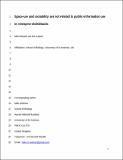Files in this item
Space-use and sociability are not related to public-information use in ninespine sticklebacks
Item metadata
| dc.contributor.author | Webster, Michael Munro | |
| dc.contributor.author | Laland, Kevin Neville | |
| dc.date.accessioned | 2016-03-21T00:01:05Z | |
| dc.date.available | 2016-03-21T00:01:05Z | |
| dc.date.issued | 2015-06 | |
| dc.identifier | 176925361 | |
| dc.identifier | 94bfb7ab-02fb-4459-9bab-03a5f68748d0 | |
| dc.identifier | 000354227000004 | |
| dc.identifier | 000354227000004 | |
| dc.identifier | 84939937133 | |
| dc.identifier.citation | Webster , M M & Laland , K N 2015 , ' Space-use and sociability are not related to public-information use in ninespine sticklebacks ' , Behavioral Ecology and Sociobiology , vol. 69 , no. 6 , pp. 895-907 . https://doi.org/10.1007/s00265-015-1901-5 | en |
| dc.identifier.issn | 0340-5443 | |
| dc.identifier.other | ORCID: /0000-0001-9597-6871/work/60427818 | |
| dc.identifier.other | ORCID: /0000-0002-2457-0900/work/60630410 | |
| dc.identifier.uri | https://hdl.handle.net/10023/8444 | |
| dc.description.abstract | There has been much recent interest in both public information use, and the evolutionary origins and ecological consequences of animal personalities but surprisingly little integration of these two fields. Personality traits may impact upon the extent to which individuals respond to public information in a number of different ways. As a first step towards addressing some of these questions, in this study, we asked whether personality traits predicted public information use in ninespine sticklebacks (Pungitius pungitius). Over a 33-day period, subjects were scored twice for a number of behavioural traits, including measures of activity, exploration and shoaling tendency, and were exposed multiple times to a public information use foraging task, in which they were required to select the richer of two prey patches based upon the foraging success of two demonstrator groups. The repeatable (r=0.38–0.58) behavioural traits were reduced to two principle components describing space use and sociability. Neither of these was found to be related to either of two measures of public information use. While the personality traits that we considered did not co-vary with public information use in this species, they may well indirectly affect opportunity for exposure to public information, and this is an obvious avenue for further research. | |
| dc.format.extent | 13 | |
| dc.format.extent | 647401 | |
| dc.language.iso | eng | |
| dc.relation.ispartof | Behavioral Ecology and Sociobiology | en |
| dc.subject | Behavioural syndrome | en |
| dc.subject | Bold-shy | en |
| dc.subject | Innovation | en |
| dc.subject | Producer-scrounger | en |
| dc.subject | Social learning strategies | en |
| dc.subject | Temperament | en |
| dc.subject | QH301 Biology | en |
| dc.subject | Animal Science and Zoology | en |
| dc.subject | Aquatic Science | en |
| dc.subject | Ecology, Evolution, Behavior and Systematics | en |
| dc.subject | NDAS | en |
| dc.subject.lcc | QH301 | en |
| dc.title | Space-use and sociability are not related to public-information use in ninespine sticklebacks | en |
| dc.type | Journal article | en |
| dc.contributor.sponsor | NERC | en |
| dc.contributor.sponsor | European Research Council | en |
| dc.contributor.institution | University of St Andrews. School of Biology | en |
| dc.contributor.institution | University of St Andrews. Scottish Oceans Institute | en |
| dc.contributor.institution | University of St Andrews. Institute of Behavioural and Neural Sciences | en |
| dc.contributor.institution | University of St Andrews. Centre for Social Learning & Cognitive Evolution | en |
| dc.contributor.institution | University of St Andrews. Centre for Biological Diversity | en |
| dc.identifier.doi | 10.1007/s00265-015-1901-5 | |
| dc.description.status | Peer reviewed | en |
| dc.date.embargoedUntil | 2016-03-21 | |
| dc.identifier.url | http://link.springer.com/article/10.1007/s00265-015-1901-5 | en |
| dc.identifier.grantnumber | NE/D010365/1 | en |
| dc.identifier.grantnumber | en |
This item appears in the following Collection(s)
Items in the St Andrews Research Repository are protected by copyright, with all rights reserved, unless otherwise indicated.

